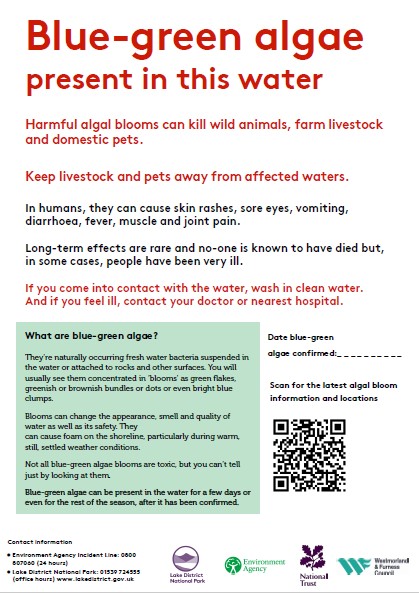Blue-green algae occurs naturally in bodies of freshwater, but some kinds can be toxic to humans and lethal to animals. It's impossible to tell if the algae is the dangerous kind just by looking at it, so it's best to not enter the water if you suspect there is algae.

For landowners to download, print out and pin up when blue-green algae spotted in water.
Please remember to remove the poster when the algae has gone. Writing a date on your poster can be helpful for visitors too.
There’s a wide range of blue-green algae (cyanobacteria). In fresh waters, they’re suspended within the water or attached to rocks and other surfaces. You usually can see them when they’re concentrated into clumps. These clumps can look like green flakes, greenish bundles or brownish dots.
Blooms can have a negative effect on the appearance, quality and use of the water. It may become green, blue-green or greenish-brown and several species can produce musty, earthy or grassy odours. Blooms can also cause foaming on the shoreline - sometimes confused with sewage pollution.
Bloom and scum forming blue-green algae can produce toxins. Toxin producing blooms are called Harmful Algal Blooms (HABs). These toxins can kill wild animals, farm livestock and domestic pets. Farmers and pet owners should keep their animals away from affected waters.
In humans, they can cause rashes after skin contact and illnesses if swallowed. Illnesses including skin rashes, eye irritation, vomiting, diarrhoea, fever and muscle and joint pain have occurred in people who’ve swallowed or swam through algal scum. These haven’t led to long-term effects or death but, in some cases, the illnesses can be severe.
Not all blue-green algae blooms and scums are toxic, but you can’t tell just by looking at them, so it’s best to assume they are. Although algal scum isn’t always harmful, avoid contact with it and the water close to it.
Please call the Environment Agency on 0800 80 70 60 to report your sighting. Do not enter, drink or swallow the water. Also keep children and pets away from the water.
Blue green algae, or algal blooms, are more likely during warm, dry weather and can occur in most water bodies. Blooms are likely to last throughout the summer season, however, they can move or break up during windy weather.
Visit: Environment Agency information on known algae locations in Cumbria
Read about the plans to improve and manage water quality in Windermere.